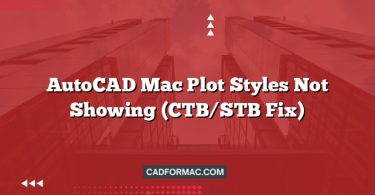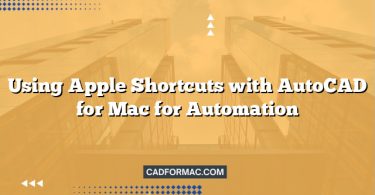AutoCAD for Mac offers a powerful design environment tailored to macOS users, and one of its most intuitive yet underutilized features is seamless integration with the MacBook trackpad. Unlike Windows counterparts that rely heavily on a mouse with a scroll wheel, Mac users can leverage multi-touch gestures to navigate, zoom, pan, and manipulate drawings with fluid precision. This guide explores how to use your Mac trackpad effectively in AutoCAD to boost productivity and streamline your workflow.
Understanding AutoCAD’s Trackpad Integration
AutoCAD for Mac is optimized for macOS’s native trackpad gestures. By default, many standard macOS gestures—such as two-finger scrolling and pinch-to-zoom—are automatically mapped to common AutoCAD navigation commands. However, to get the most out of your trackpad, it’s essential to understand both the default behaviors and how to customize them for your specific needs.
Default Trackpad Behaviors in AutoCAD Mac
- Two-Finger Scroll: Pans the drawing area horizontally and vertically.
- Pinch-to-Zoom: Zooms in and out smoothly, similar to using the scroll wheel with Ctrl pressed on a mouse.
- Two-Finger Tap: Acts as a right-click (context menu).
- Three-Finger Swipe: By default, this may trigger macOS system gestures (like switching between apps), but can be repurposed within AutoCAD through customization.
Note: Ensure your macOS Trackpad settings are configured for optimal performance. Go to System Settings > Trackpad and verify that “Scroll & Zoom” gestures are enabled.
Essential Trackpad Gestures for Navigation
1. Panning with Two-Finger Drag
Instead of holding the middle mouse button, simply place two fingers on the trackpad and drag in any direction to pan across your drawing. This gesture is smooth, responsive, and ideal for large drawings where you need to move quickly between areas.
Pro Tip: For faster panning, increase the tracking speed in System Settings > Trackpad > Point & Click.
2. Zooming with Pinch Gestures
Place two fingers on the trackpad and pinch inward to zoom out or spread them apart to zoom in. This provides a natural, tactile way to adjust your view without reaching for toolbar icons or keyboard shortcuts.
Customization Option: If you prefer the traditional scroll-wheel zoom behavior (zooming toward the cursor), you can enable this by adjusting AutoCAD’s ZOOMFACTOR or using the ZOOMWHEEL system variable (set to 1).
3. Orbiting 3D Views (For 3D Drawings)
In 3D modeling workspaces, use a two-finger rotate gesture (circular motion with two fingers) to orbit around your model. This mimics the 3DORBIT command and provides intuitive spatial navigation.
Requirement: Ensure you’re in a 3D visual style (e.g., Realistic or Shaded) and that hardware acceleration is enabled (Preferences > Display > Graphics Performance).
Advanced Trackpad Techniques
Using Gestures with Modifier Keys
Combine trackpad gestures with keyboard modifiers for enhanced control:
- Option + Two-Finger Drag: Temporarily switches to real-time pan, even if another command is active.
- Command + Pinch: Zooms with finer control (slower zoom rate).
- Shift + Two-Finger Vertical Scroll: Constrains panning to vertical movement only.
Customizing Gestures via AutoCAD Preferences
While AutoCAD for Mac doesn’t offer a full gesture-mapping interface like some third-party apps, you can influence trackpad behavior through system variables and preferences:
- Open AutoCAD > Preferences > User Preferences.
- Under Windows Elements, ensure “Use Mac-native scroll bars” is checked for consistent behavior.
- In the 3D Graphics tab, adjust orbit sensitivity if 3D navigation feels too fast or slow.
Additionally, consider using AutoCAD’s Action Recorder to create macros triggered by keyboard shortcuts that complement your trackpad workflow.
Troubleshooting Common Trackpad Issues
Issue: Trackpad Gestures Not Working
- Solution: Verify that “Scroll direction: natural” is consistent with your preference. Some users find reversing this setting (in macOS Trackpad settings) improves AutoCAD navigation feel.
- Ensure no third-party apps (e.g., BetterTouchTool) are intercepting gestures before AutoCAD receives them.
Issue: Zoom/Pan Feels Laggy or Jittery
- Solution: Reduce visual complexity by switching to 2D Wireframe visual style temporarily.
- Close unused palettes and disable hardware acceleration if your Mac has older graphics hardware (Preferences > Display > Graphics Performance).
Issue: Right-Click (Two-Finger Tap) Opens macOS Context Menu Instead of AutoCAD’s
- Solution: In System Settings > Trackpad > Point & Click, ensure “Secondary click” is set to “Click or tap with two fingers.” AutoCAD should then correctly interpret this as a right-click within the drawing area.
Best Practices for Trackpad Efficiency
- Keep Your Trackpad Clean: A clean, dry trackpad ensures accurate gesture recognition.
- Use Full-Screen Mode: Maximize your drawing area by entering full-screen mode (View > Full Screen), reducing distractions and giving gestures more space.
- Combine with Keyboard Shortcuts: Use trackpad for navigation and keyboard for commands (e.g.,
Lfor Line,Cfor Circle) to maintain a fluid workflow. - Adjust Gesture Sensitivity: In macOS Trackpad settings, fine-tune “Tracking speed” and “Scrolling speed” to match your drawing style.
Frequently Asked Questions (FAQ)
Can I use three- or four-finger trackpad gestures in AutoCAD for Mac?
AutoCAD for Mac does not natively support three- or four-finger macOS gestures (like app switching or Mission Control) within the drawing window. These gestures are handled by the operating system and typically trigger system-level actions. However, you can disable system gestures in System Settings > Trackpad to prevent accidental triggers while working in AutoCAD. For now, AutoCAD only fully recognizes two-finger gestures (scroll, zoom, tap) and limited three-finger actions if remapped via third-party tools—but this is not officially supported.
Why does pinch-to-zoom sometimes zoom to the center of the screen instead of my cursor location?
By default, AutoCAD for Mac’s pinch-to-zoom gesture zooms relative to the center of the current view, not the cursor position. This differs from the mouse scroll-wheel zoom (with Ctrl), which zooms toward the cursor. To zoom toward your cursor using the trackpad, hold the Option key while pinching. Alternatively, set the system variable ZOOMFACTOR to a lower value (e.g., 5–10) for more controlled zooming, or use the Zoom > Center command manually for precision.
Does AutoCAD for Mac support Force Touch or haptic feedback on compatible trackpads?
No, AutoCAD for Mac does not currently utilize Force Touch pressure sensitivity or haptic feedback features on MacBook Pro or Magic Trackpad devices. All trackpad interactions are based on standard multi-touch gestures without pressure-based commands. Autodesk has not announced plans to integrate Force Touch functionality as of the latest version.
Can I disable trackpad gestures only in AutoCAD without affecting other apps?
Not directly within AutoCAD. Gesture behavior is controlled at the macOS system level. However, you can use third-party utilities like BetterTouchTool or Karabiner-Elements to create app-specific gesture profiles that disable or remap trackpad actions only when AutoCAD is active. This allows you to keep full gesture support in other applications while customizing or limiting them in AutoCAD for better control.
Is trackpad performance affected by AutoCAD’s graphics settings?
Yes. If hardware acceleration is disabled or your Mac’s GPU is under heavy load, trackpad navigation (especially in 3D views) may feel sluggish or unresponsive. To optimize performance:
- Go to AutoCAD > Preferences > Display and enable Use hardware acceleration.
- Ensure you’re using a supported macOS version and updated graphics drivers.
- Reduce visual complexity by switching to 2D Wireframe when detailed rendering isn’t needed.
How do I simulate a middle mouse button click using the trackpad?
AutoCAD for Mac doesn’t require a middle mouse button for most operations, as trackpad gestures replace traditional mouse functions (e.g., two-finger drag for pan). However, if a command specifically requests a middle-click (such as exiting real-time pan or accessing the object snap menu), you can:
- Use Option + Command + Click to simulate a middle-click.
- Alternatively, enable “Middle mouse button” emulation via third-party tools like BetterTouchTool by assigning a corner tap or three-finger click to send a middle-button event.
Conclusion
The MacBook trackpad is more than just a pointing device—it’s a powerful navigation tool that, when used effectively, can significantly enhance your experience in AutoCAD for Mac. By mastering pinch-to-zoom, two-finger pan, and contextual gestures—and pairing them with smart customization—you’ll enjoy a smoother, more intuitive design process that leverages the full potential of macOS and AutoCAD’s native integration.
Whether you’re drafting 2D plans or modeling complex 3D structures, your trackpad can become an extension of your creative workflow. Take time to experiment with these techniques, adjust settings to your preference, and soon you’ll navigate your drawings as naturally as you swipe through photos on your Mac.




